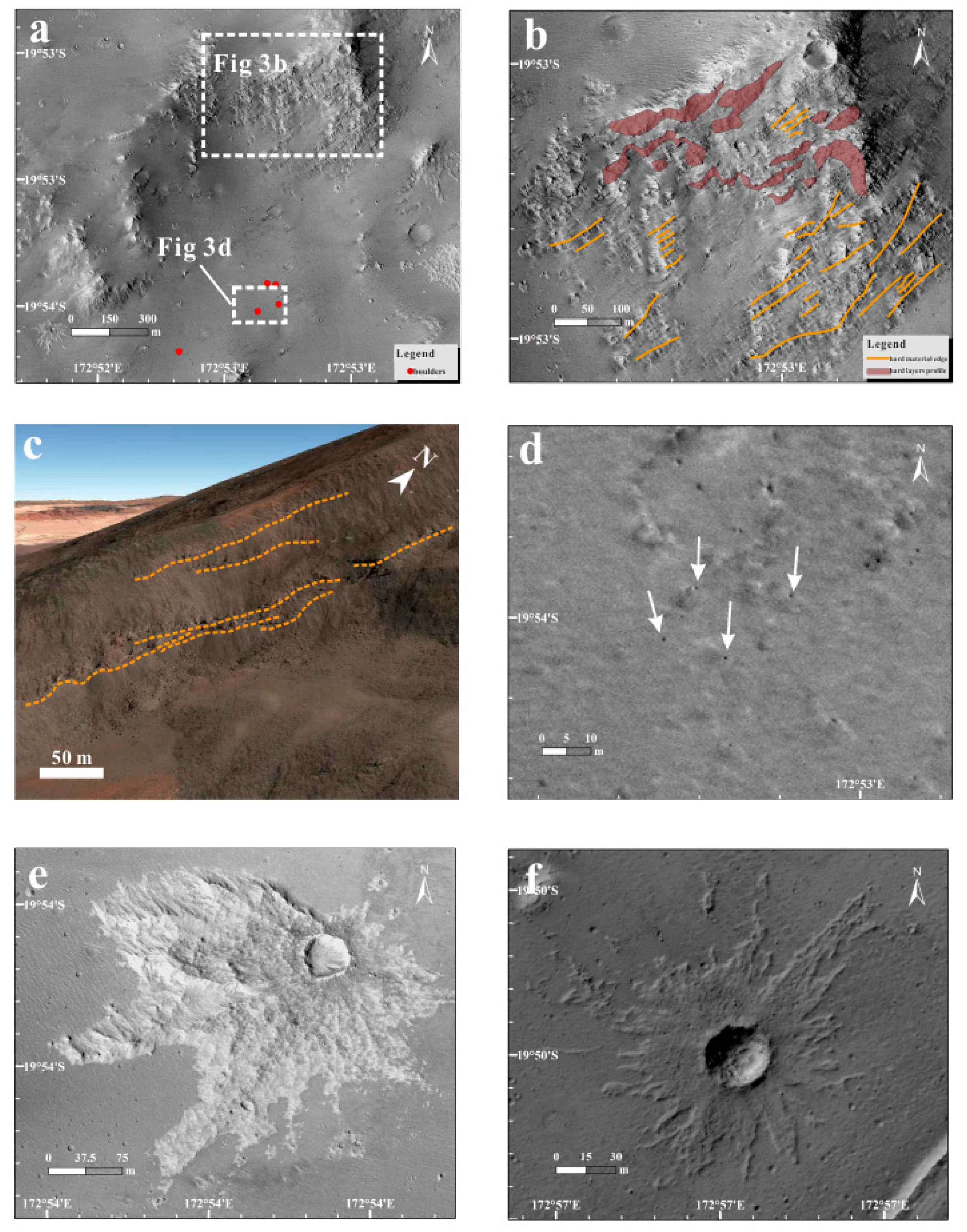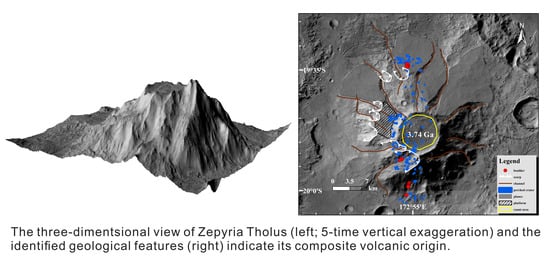New Evidence to Support Zephyria Tholus as a Composite Volcano on Mars
Abstract
:1. Introduction
2. Methods
3. Results
3.1. Age
3.2. Geomorphology Features
3.2.1. Valleys, Planèzes and Channels
3.2.2. Layered Materials
3.2.3. Perched Craters




4. Discussion

5. Conclusions
Author Contributions
Funding
Institutional Review Board Statement
Informed Consent Statement
Data Availability Statement
Acknowledgments
Conflicts of Interest
References
- Werner, S.C. The global martian volcanic evolutionary history. Icarus 2009, 201, 44–68. [Google Scholar] [CrossRef]
- Xiao, L.; Huang, J.; Christensen, P.R.; Greeley, R.; Williams, D.A.; Zhao, J.; He, Q. Ancient volcanism and its implication for thermal evolution of Mars. Earth Planet. Sci. Lett. 2012, 323, 9–18. [Google Scholar] [CrossRef]
- Carr, M.H. Volcanism on mars. J. Geophys. Res. 1973, 78, 4049–4062. [Google Scholar] [CrossRef]
- Greeley, R.; Spudis, P.D. Volcanism on mars. Rev. Geophys. 1981, 19, 13–41. [Google Scholar] [CrossRef]
- Zimbelman, J.; Garry, W.; Bleacher, J.; Crown, D. Volcanism on Mars. In The Encyclopedia of Volcanoes; Academic Press: Cambridge, MA, USA, 2015; Chapter 41. [Google Scholar]
- Peterson, J. Volcanism in the Noachis-Hellas region of Mars, 2. In Proceedings of the Lunar and Planetary Science Conference Proceedings, Houston, TX, USA, 13–17 March 1978; pp. 3411–3432. [Google Scholar]
- Williams, D.A.; Greeley, R.; Zuschneid, W.; Werner, S.C.; Neukum, G.; Crown, D.A.; Gregg, T.K.; Gwinner, K.; Raitala, J. Hadriaca Patera: Insights into its volcanic history from Mars express high resolution stereo camera. J. Geophys. Res. Planets 2007, 112, E10. [Google Scholar] [CrossRef] [Green Version]
- Williams, D.A.; Greeley, R.; Werner, S.C.; Michael, G.; Crown, D.A.; Neukum, G.; Raitala, J. Tyrrhena Patera: Geologic history derived from Mars express high resolution stereo camera. J. Geophys. Res. Planets 2008, 113, E11. [Google Scholar] [CrossRef] [Green Version]
- Huang, J.; Xiao, L. Knobby terrain on ancient volcanoes as an indication of dominant early explosive volcanism on Mars. Geophys. Res. Lett. 2014, 41, 7019–7024. [Google Scholar] [CrossRef]
- Tanaka, K.L.; Skinner, J.A., Jr.; Dohm, J.M.; Irwin, R.P., III; Kolb, E.J.; Fortezzo, C.M.; Platz, T.; Michael, G.G.; Hare, T.M. Geologic Map of Mars. 2014. Available online: https://pubs.usgs.gov/sim/3292/ (accessed on 11 December 2020).
- Bandfield, J.L.; Edwards, C.S.; Montgomery, D.R.; Brand, B.D. The dual nature of the martian crust: Young lavas and old clastic materials. Icarus 2013, 222, 188–199. [Google Scholar] [CrossRef]
- King, J.S.; Riehle, J.R. A proposed origin of the Olympus Mons escarpment. Icarus 1974, 23, 300–317. [Google Scholar] [CrossRef]
- Mouginis-Mark, P.; Wilson, L.; Zimbelman, J.R. Polygenic eruptions on Alba Patera, Mars. Bull. Volcanol. 1988, 50, 361–379. [Google Scholar] [CrossRef]
- Stewart, E.M.; Head, J.W. Ancient Martian volcanoes in the Aeolis region: New evidence from MOLA data. J. Geophys. Res. Planets 2001, 106, 17505–17513. [Google Scholar] [CrossRef]
- Smith, D.E.; Zuber, M.T.; Frey, H.V.; Garvin, J.B.; Head, J.W.; Muhleman, D.O.; Pettengill, G.H.; Phillips, R.J.; Solomon, S.C.; Zwally, H.J. Mars Orbiter Laser Altimeter: Experiment summary after the first year of global mapping of Mars. J. Geophys. Res. Planets 2001, 106, 23689–23722. [Google Scholar] [CrossRef]
- Christensen, P.R.; Jakosky, B.M.; Kieffer, H.H.; Malin, M.C.; McSween, H.Y.; Nealson, K.; Mehall, G.L.; Silverman, S.H.; Ferry, S.; Caplinger, M. The thermal emission imaging system (THEMIS) for the Mars 2001 Odyssey Mission. Space Sci. Rev. 2004, 110, 85–130. [Google Scholar] [CrossRef]
- Edwards, C.; Nowicki, K.; Christensen, P.; Hill, J.; Gorelick, N.; Murray, K. Mosaicking of global planetary image datasets: 1. Techniques and data processing for Thermal Emission Imaging System (THEMIS) multi-spectral data. J. Geophys. Res. Planets 2011, 116, E10. [Google Scholar] [CrossRef]
- Malin, M.C.; Bell, J.F.; Cantor, B.A.; Caplinger, M.A.; Calvin, W.M.; Clancy, R.T.; Edgett, K.S.; Edwards, L.; Haberle, R.M.; James, P.B. Context camera investigation on board the Mars Reconnaissance Orbiter. J. Geophys. Res. Planets 2007, 112, E5. [Google Scholar] [CrossRef] [Green Version]
- Dickson, J.; Kerber, L.; Fassett, C.; Ehlmann, B. A global, blended CTX mosaic of Mars with vectorized seam mapping: A new mosaicking pipeline using principles of non-destructive image editing. In Proceedings of the Lunar and planetary science conference, The Woodlands, TX, USA, 19–23 March 2018; pp. 1–2. [Google Scholar]
- McEwen, A.S.; Eliason, E.M.; Bergstrom, J.W.; Bridges, N.T.; Hansen, C.J.; Delamere, W.A.; Grant, J.A.; Gulick, V.C.; Herkenhoff, K.E.; Keszthelyi, L. Mars reconnaissance orbiter’s high resolution imaging science experiment (HiRISE). J. Geophys. Res. Planets 2007, 112, E5. [Google Scholar] [CrossRef] [Green Version]
- Shean, D.E.; Alexandrov, O.; Moratto, Z.M.; Smith, B.E.; Joughin, I.R.; Porter, C.; Morin, P. An automated, open-source pipeline for mass production of digital elevation models (DEMs) from very-high-resolution commercial stereo satellite imagery. ISPRS J. Photogramm. Remote Sens. 2016, 116, 101–117. [Google Scholar] [CrossRef] [Green Version]
- Kneissl, T.; van Gasselt, S.; Neukum, G. Map-projection-independent crater size-frequency determination in GIS environments—New software tool for ArcGIS. Planet. Space Sci. 2011, 59, 1243–1254. [Google Scholar] [CrossRef]
- Michael, G.; Neukum, G. Surface dating: Software tool for analysing crater size-frequency distributions including those showing partial resurfacing events. In Proceedings of the Lunar and Planetary Science Conference, League City, TX, USA, 10–14 March 2008; p. 1780. [Google Scholar]
- Ivanov, B.A. Mars/Moon cratering rate ratio estimates. Space Sci. Rev. 2001, 96, 87–104. [Google Scholar] [CrossRef]
- Neukum, G.; Ivanov, B.A.; Hartmann, W.K. Cratering records in the inner solar system in relation to the lunar reference system. Chronol. Evol. Mars 2001, 96, 55–86. [Google Scholar] [CrossRef]
- Davidson, J.; De Silva, S. Composite volcanoes. Encycl. Volcanoes 2000, 1, 663–681. [Google Scholar]
- Ollier, C.; Terry, J. Volcanic geomorphology of northern Viti Levu, Fiji. Aust. J. Earth Sci. 1999, 46, 515–522. [Google Scholar] [CrossRef]
- Kadish, S.J.; Head, J.W. Impacts into non-polar ice-rich paleodeposits on Mars: Excess ejecta craters, perched craters and pedestal craters as clues to Amazonian climate history. Icarus 2011, 215, 34–46. [Google Scholar] [CrossRef]
- Plescia, J. Morphometric properties of Martian volcanoes. J. Geophys. Res. Planets 2004, 109, E3. [Google Scholar] [CrossRef]
- de Silva, S.; Lindsay, J.M. Primary volcanic landforms. In The Encyclopedia of Volcanoes; Elsevier: Amsterdam, The Netherlands, 2015; pp. 273–297. [Google Scholar]
- Lacey, A.; Ockendon, J.; Turcotte, D. On the geometrical form of volcanoes. Earth Planet. Sci. Lett. 1981, 54, 139–143. [Google Scholar] [CrossRef]
- Wörner, G.; Hammerschmidt, K.; Henjes-Kunst, F.; Lezaun, J.; Wilke, H. Geochronology (40Ar/39Ar, K-Ar and He-exposure ages) of Cenozoic magmatic rocks from northern Chile (18-22 S): Implications for magmatism and tectonic evolution of the central Andes. Rev. Geológica De Chile 2000, 27, 205–240. [Google Scholar]
- Francis, P.; Wells, G. Landsat Thematic Mapper observations of debris avalanche deposits in the Central Andes. Bull. Volcanol. 1988, 50, 258–278. [Google Scholar] [CrossRef]
- Francis, P.; De Silva, S. Application of the Landsat Thematic Mapper to the identification of potentially active volcanoes in the Central Andes. Remote Sens. Environ. 1989, 28, 245–255. [Google Scholar] [CrossRef]
- de Vries, B.v.W.; Kerle, N.; Petley, D. Sector collapse forming at Casita volcano, Nicaragua. Geology 2000, 28, 167–170. [Google Scholar] [CrossRef]
- Espinasa-Pereña, R.; Pozzo, A. Morphostratigraphic evolution of Popocatépetl volcano, México. Spec. Pap.-Geol. Soc. Am. 2006, 402, 115. [Google Scholar]
- Robbins, S.J.; Di Achille, G.; Hynek, B.M. The volcanic history of Mars: High-resolution crater-based studies of the calderas of 20 volcanoes. Icarus 2011, 211, 1179–1203. [Google Scholar] [CrossRef]
- Brož, P.; Bernhardt, H.; Conway, S.J.; Parekh, R. An overview of explosive volcanism on Mars. J. Volcanol. Geotherm. Res. 2020, 409, 107125. [Google Scholar] [CrossRef]
- Head, J.W.; Wilson, L. Tharsis Montes as composite volcanoes? The role of explosive volcanism in edifice construction and implications for the volatile contents of edifice-forming magmas. In Proceedings of the Lunar and Planetary Science Conference, Houston, TX, USA, 16–20 March 1998; p. 1127. [Google Scholar]
- Catling, D.C. Atmospheric Evolution, Mars. In Encyclopedia of Paleoclimatology and Ancient Environments; Gornitz, V., Ed.; Springer: Dordrecht, The Netherlands, 2009; pp. 66–75. [Google Scholar]
- Taddeucci, J.; Edmonds, M.; Houghton, B.; James, M.R.; Vergniolle, S. Hawaiian and Strombolian eruptions. In The encyclopedia of Volcanoes; Elsevier: Amsterdam, The Netherlands, 2015; pp. 485–503. [Google Scholar]
- Wilson, L.; Head, J.W., III. Mars: Review and analysis of volcanic eruption theory and relationships to observed landforms. Rev. Geophys. 1994, 32, 221–263. [Google Scholar] [CrossRef] [Green Version]
Publisher’s Note: MDPI stays neutral with regard to jurisdictional claims in published maps and institutional affiliations. |
© 2021 by the authors. Licensee MDPI, Basel, Switzerland. This article is an open access article distributed under the terms and conditions of the Creative Commons Attribution (CC BY) license (https://creativecommons.org/licenses/by/4.0/).
Share and Cite
Wang, L.; Zhao, J.; Huang, J.; Xiao, L. New Evidence to Support Zephyria Tholus as a Composite Volcano on Mars. Remote Sens. 2021, 13, 3891. https://doi.org/10.3390/rs13193891
Wang L, Zhao J, Huang J, Xiao L. New Evidence to Support Zephyria Tholus as a Composite Volcano on Mars. Remote Sensing. 2021; 13(19):3891. https://doi.org/10.3390/rs13193891
Chicago/Turabian StyleWang, Le, Jiannan Zhao, Jun Huang, and Long Xiao. 2021. "New Evidence to Support Zephyria Tholus as a Composite Volcano on Mars" Remote Sensing 13, no. 19: 3891. https://doi.org/10.3390/rs13193891
APA StyleWang, L., Zhao, J., Huang, J., & Xiao, L. (2021). New Evidence to Support Zephyria Tholus as a Composite Volcano on Mars. Remote Sensing, 13(19), 3891. https://doi.org/10.3390/rs13193891







